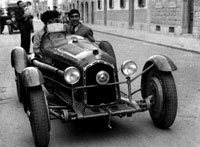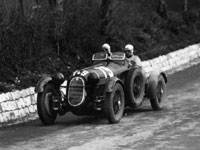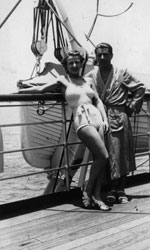
|
NOTE: You are viewing the OLD VeloceToday website. We are in the process of moving some of the old articles from the OLD site to the NEW site.
|

|

|

|


Home
Cars
Racing
News
People
Lifestyle
Events

|

|

|
People
|

|

|
Carlo Pintacuda - Part II
By Estanislao Iacona & Cristi�n Bertschi
Photos courtesy of the Carlo Pintacuda Collection


Not a Monza but a P3, with a larger cockpit, lights and fenders. Pintacuda convinced Ferrari
that the new P3 was an ideal car for the Mille Miglia, and proved it by winning the 1935 1000 mile race.
|
The Scuderia days
After the formalities, Carlo jumped into the car and made 70 laps. When the test ended he said, "If you could adapt this car for the Mille Miglia, it would be a winner". He was very impressed with the power of the Tipo B. Ferrari had already entered a brace of 2.3 Alfas and 2.6 Monzas, but decided to help Pintacuda with the P3. The agreement included the assistance of the Scuderia during the race. According to Giovanni Lurani, the "single seat Alfa P3 was powered by a 2654cc engine with twin superchargers, developing 220 bhp at 5500 rpm. Transforming this 'monoposto' into a sportscar involved fitting two small seats, moving the steering wheel and fitting a self starter, dynamo, lights, spare wheel, battery and mudguards." Only the wiry Pintacuda could fit behind the wheel, and his co-driver was a brave fellow Tuscan, the Marquis Della Stufa, who also barely fit into the confined cockpit.
One day before the race started, while testing in Brescia, the gearbox showed serious problems. After a quick phone call to "Don" Enzo four mechanics with spare parts arrived, and after working from 8 at night to 6 in the morning, the P3 was ready for the start. Evidently, the work was well done, as Pintacuda won by more than 40 minutes over the Alfa of Tadini-Chiari. After the epic Mille Miglia win, Ferrari decided to hire Pintacuda as an official Scuderia driver. But in 1935, always at the wheel of a P3, he was not very lucky. In 18 starts he placed third 14 times and had four DNFs.


Pintacuda at the Mille Miglia with the "boticella" 8C2900 in 1936. Again, with thinly disguised
Grand Prix cars, Alfa took the first three places in the event. Pintacuda placed third.
|
The new Alfa 2.9, based on the Grand Prix cars with four-wheel independent suspension, dominated the 1936 Mille Miglia. Pintacuda managed to place third, behind Brivio and Farina, after suffering carburetor problems. Gaining a position on the Grand Prix team, Pintacuda was fifth in Tripoli with the new 8-cylinder Alfa, behind the powerful Auto Unions and Mercedes Benz. As a reward, Ferrari sent Pintacuda to Brazil with the new 8C2900 "boticellas". Once in Rio de Janeiro, neither he nor Marinoni were lucky. Carlo retired while leading with differential problems. But he would have a second chance in San Pablo, where he won after leading the entire race, thanks to new differential gears having arrived from Italy.
1937 was a year full of success. It started with a Mille Miglia win and continued with a great win in Rio de Janeiro in the "Trampolin do Diabo", the Devil's Springboard. The Mille Miglia was contested in a deluge, and the French Delahaye cars of Dreyfus/Ghersi, and Schell/Carrierre posed a significant threat to the Alfa team. The Alfas were similar to the 1936 entries, but now had 260 bhp and a top speed of over 130mph. Pintacuda drove flat out from the start, and broke all existing records on the Brescia to Bologna stage. Notably, he also led at Rome, breaking the long standing rule that "those who lead at Rome will not win the Mille Miglia." Dreyfus was gaining on Pintacuda, but left the road at Tolentino. Experiencing electrical problems, Carlo drove without lights, following his teammate Farina to the finish, winning his second great victory in the Mille Miglia.


His boarding pass states Pintacuda sailed alone to South America in 1937, but he was never without exemplary company.
|
On June 6th, Pintacuda traveled to South America for the Rio de Janeiro Grand Prix. He was to drive an Alfa 8C 35 with a blown 3800cc engine, as raced at Tripoli the year before. His rival was Hans von Stuck who drove a more powerful Auto Union. It was not an easy situation. The German car had 100 hp over the Alfa and Pintacuda could only hope that only that the wet track would be to his advantage. The race started under heavy rain and von Stuck took the lead, but on the second lap, Pintacuda passed him and at half distance he was still leading by 18 seconds. By then, the rain had stopped and a strong wind started to blow over the track. The Auto Union appeared in the mirrors of the Alfa and quickly passed. Pintacuda thought that if he could follow the German he would be able to pass him on the last lap at a place on the circuit where the Italian car had a better acceleration due to the lower weight. However, fours laps before the end, von Stuck had to go to the pits for refueling and Pintacuda was leading again by 20 seconds, after having set a new lap record of 7 minutes 10 seconds. If he had to pit, Pintacuda would lose first place, so he had to drive very carefully. When he was 2 km from the checkered flag, at 200 km/h, the Alfa ran out of petrol! However, Pintacuda coasted to the finish in first, with von Stuck four seconds behind.
The Monaco Grand Prix, held late in the season on August 8th, 1937, was a total disappointment, as the new low-chassis Alfa V-12 was not yet ready. The entry consisted of the aging 1936 12C models for Farina, Brivio and Pintacuda, as well as two even older 8Cs for Sommer and Ruesch. On the first lap, as an Auto Union that was behind Pintacuda crashed and came back on the track, Carlo stepped on the brake pedal but could not avoid to hitting his teammate Brivio, damaging the front brakes. He went to the pits several times but the brake problem could not be solved. He finished 9th, bravely driving the Monaco G.P. without brakes.
. . . . . . .
Part I- A Pre-War Hero Part I
Part III- The 1938 Mille Miglia and Beyond
|

|
|

|
|



